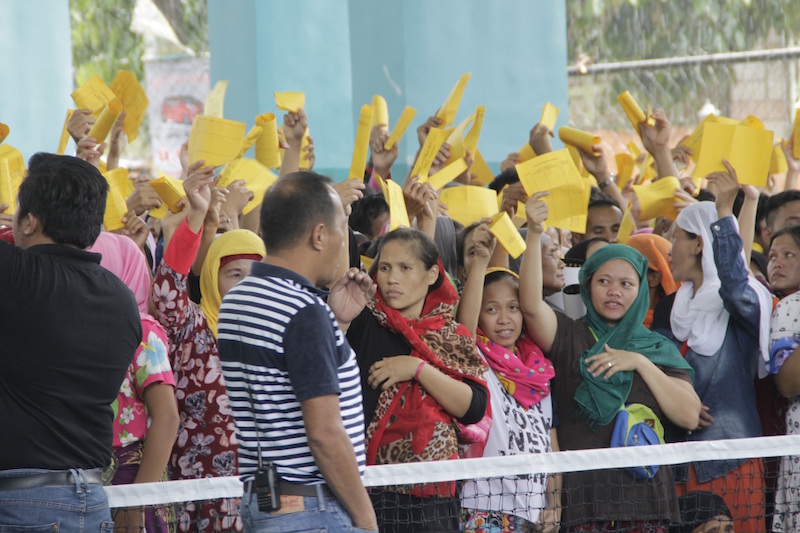MARAWI CITY (MindaNews / 31 May) — A total of 140,155 residents, representing nearly 70% of this city’s total population, have fled to neighboring towns and cities since the clashes between government forces and the Maute Group here began on May 23, ARMM Assemblyman Zia Alonto Adiong, spokesperson of the Provincial Crisis Management Office, said.
 A deserted street in Marawi City, 31 May 2017. Nearly 70% of its total population of 201,785 fled the city due to ongoing clashes between government forces and terrorists. MindaNews photo by CAROLYN O. ARGUILLAS
A deserted street in Marawi City, 31 May 2017. Nearly 70% of its total population of 201,785 fled the city due to ongoing clashes between government forces and terrorists. MindaNews photo by CAROLYN O. ARGUILLAS
The country’s lone Islamic City, which has 96 barangays and a population of 201,785 based on the 2015 Census of Population of the Philippine Statistics Authority (PSA), is the most populous area in the five-province, two-city Autonomous Region in Muslim Mindanao (ARMM), according to PSA records.
Until May 23, that is.
The number of residents displaced by the ongoing clashes in Marawi City from May 23 until May 30 and the aerial strikes that have been lending support to ground forces has reached 140,155, Adiong said at the press briefing at the Operations Center of the Provincial Crisis Management Committee at the Provincial Capitol here Wednesday.
The number represents 69.5% of the city’s population.
There is no figure yet as to the number of transients trapped in the city since May 23 although transients from the Mindanao State University have been evacuated. Transients include visitors, construction workers, university employees, store vendors, as well as company employees and teachers who happened to be in Marawi when the clashes began. Forty-two teachers from Wao in Lanao del Sur who were attending a seminar were among those trapped but are now back in Wao.
The Provincial Capitol itself is relying on volunteers to take on the jobs left behind by a number of employees who fled Marawi.
Adiong told MindaNews that 21,882 families or 109,510 individuals are home-based; 4,838 families or 24,190 individuals are in evacuation centers and 1,291 families or 6,455 individuals are in Marawi City.
He said there are no reported evacuation of residents in neighboring towns. The evacuees reportedly from Kapai were actually Marawi residents.
The Department of Social Welfare and Development (DSWD) as of 6 a.m. on May 31 listed a total 18,609 families or 92,628 persons displaced from Marawi.
 Assemblyman Zia Alonto Adiong, spokesperson of the Provincial Crisis Management Committee at the press briefing on 31 May 2017. MindaNews photo by CAROLYN O. ARGUILLAS
Assemblyman Zia Alonto Adiong, spokesperson of the Provincial Crisis Management Committee at the press briefing on 31 May 2017. MindaNews photo by CAROLYN O. ARGUILLAS
Adiong said to avoid confusion on data, it has been agreed upon that the DSWD in Region 10 (Northern Mindanao) will focus on residents who fled Marawi and evacuated in Lanao del Norte towns while those in Lanao del Sur will be handled by DSWD in the ARMM and the Lanao del Sur PMC.
Lanao del Sur belongs to the ARMM while Lanao del Norte belongs to Region 10.
In Balo-i, Lanao del Norte, thousands of evacuees waved yellow validation slips Tuesday afternoon as they awaited release of their relief goods inside the municipal covered court while thousands more are staying at the municipal gym across.
 Bakwits from Marawi wave their yellow validation slips as they await the release of relief goods at the municipal covered court in Balo-i, Lanao del Norte on Tuesday, 30 May 2017. MindaNews photo by H. MARCOS C. MORDENO
Bakwits from Marawi wave their yellow validation slips as they await the release of relief goods at the municipal covered court in Balo-i, Lanao del Norte on Tuesday, 30 May 2017. MindaNews photo by H. MARCOS C. MORDENO
Records collated by the DSWD at the covered court showed a total of 613 households from Marawi who fled to Barangay East Poblacion and Barangay West Poblacion, 323 to Barangay East and 290 to Barangay West.
Most of those who fled Marawi City evacuated for the first time in their lives. A number of those who were awaiting release of relief goods are staying with relatives in these barangays.
There has not been a mass evacuation of this sort in Marawi City, “not even during the 1970s,” lawyer Naguib Sinarimbo, one of the volunteers at the PCMC, said.
“Mahirap maging evacuate lalo na pag wala kang dalang pera” (It’s difficult to be an evacuee especially if you don’t have money), said Sittie Fatima, 28, a mother of five.
A number of them fear returning to Marawi to find their homes gone from the aerial bombardments. “Wala na kaming babalikan” (We will not have homes to go back to), Sittie Fatima said.
The gym behind the barangay hall in Maria Cristina Falls, houses 270 families or, 1,026 individuals who share three toilets and three bathing facilities.
Myrna Sultan, 65, of Barangay Lilod in Marawi, said they stayed three nights in Marawi City from May 23, thinking the fighting would stop the next day. They fled on Friday because in those three nights when they stayed on, “palakas nang palakas, palapit nang palapit ang putukan” (the gunfire was getting louder and nearer). (Carolyn O. Arguillas / MindaNews)
